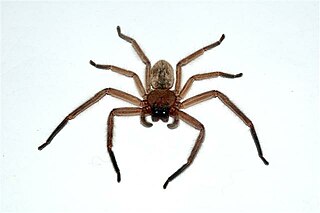
Huntsman spiders, members of the family Sparassidae, are known by this name because of their speed and mode of hunting. They are also called giant crab spiders because of their size and appearance. Larger species sometimes are referred to as wood spiders, because of their preference for woody places. In southern Africa the genus Palystes are known as rain spiders or lizard-eating spiders. Commonly, they are confused with baboon spiders from the Mygalomorphae infraorder, which are not closely related.

Heteropoda venatoria is a species of spider in the family Sparassidae, the huntsman spiders. It is native to the tropical regions of the world, and it is present in some subtropical areas as an introduced species. Its common names include giant crab spider, pantropical huntsman spider or cane spider.

Missulena is a genus of mygalomorph spiders in the family Actinopodidae. It was first described by Charles Walckenaer in 1805, and is a senior synonym of Eriodon. M. tussulena is found in Chile, but the rest are indigenous to Australia. They are sometimes referred to as "mouse spiders" from the now-disproven belief that they dig deep burrows similar to those of mice. Scotophaeus blackwalli is also called a "mouse spider", but it is smaller and not closely related.

Micrommata is a genus of huntsman spiders that was first described by Pierre André Latreille in 1804.

Delena is a genus of South Pacific huntsman spiders that was first described by Charles Athanase Walckenaer in 1837.

A social spider is a spider species whose individuals form relatively long-lasting aggregations. Whereas most spiders are solitary and even aggressive toward other members of their own species, some hundreds of species in several families show a tendency to live in groups, often referred to as colonies.

The giant huntsman spider is a species of the huntsman spider family Sparassidae found in Laos. It is considered the world's largest spider by leg span, which can reach up to 30 cm (1 ft).

Cerbalus aravaensis is a huntsman spider found in the southern Arava Valley of Israel and Jordan. The species was first described by Gershom Levy of the Hebrew University of Jerusalem in 2007, though news agencies later reported it in 2010 as a new discovery by a team of biologists from the University of Haifa. The spider has a leg span of 14 centimetres (5.5 in), making it the largest member of the family Sparassidae in the Middle East. Males have a body length of 1.85–2.40 centimetres (0.73–0.94 in), while females' body length is 2.20–2.65 centimetres (0.87–1.04 in).

New Zealand has 1157 described spider species, with an estimated total fauna of 2000 species. Over 97 per cent are endemic, and the rest have been introduced through human activities or were natural wind-borne introductions.

Heteropoda cervina, commonly called the brown huntsman, is a large species of spider in the family Sparassidae often found in leaf litter in central Queensland, Australia. The species was first described by Ludwig Carl Christian Koch in 1875 as Sarotes cervinus.

Holconia is a genus of Southern Pacific huntsman spiders that was first described by Tamerlan Dahls Thorell in 1877. It was branched from Isopeda in 1990.
David B. Hirst is an arachnologist previously based at the South Australian Museum in Adelaide. He left the Museum on 22 February 2011. He has described more than 40 species and genera in the huntsman spider family, Sparassidae, and was regularly called on by New Zealand authorities to identify huntsman spiders that entered their country.

Palystes is a genus of huntsman spiders, commonly called rain spiders or lizard-eating spiders, occurring in Africa, India, Australia, and the Pacific. The most common and widespread species is P. superciliosus, found in South Africa, home to 12 species in the genus. The name Palystes is derived from either the Latin palaestes or the Greek palaistes, meaning "wrestler". The genus was first described by Ludwig Carl Christian Koch in 1875.

Olios is the largest genus of huntsman spiders, containing 166 species. They are found throughout the world, with most species occurring in hot countries. The genus was first described by Charles Athanase Walckenaer in 1837.

Pandercetes is a genus of huntsman spiders that was first described by Ludwig Carl Christian Koch in his 1875 treatise on Australian spiders. They are mainly distributed in tropical Asia and Australia, and are known for their cryptic coloration that matches local moss and lichen. Their legs have lateral hairs, giving them a feathery appearance, further masking their outline against tree trunks. Their head is somewhat elevated and the carapace has the thoracic region low and flat.

Spariolenus is a genus of Asian huntsman spiders that was first described by Eugène Louis Simon in 1880. They are found in the Middle East reaching 15-16cm.
Keilira is a genus of Australian huntsman spiders that was first described by D. B. Hirst in 1989. As of September 2019 it contains two species, found in South Australia and Victoria: K. sokoli and K. sparsomaculata.

Polybetes is a genus of South American huntsman spiders that was first described by Eugène Louis Simon in 1897. It is a senior synonym of Leptosparassus and Streptaedoea.
Thunberga is a genus of east African huntsman spiders. The genus was first described by Peter Jäger in 2020, and it has only been found on Madagascar and on Mayotte. It is named after the environmental activist Greta Thunberg.

















